Click on images to enlarge

dense infestation (Photo: Sheldon Navie)

a large infestation of old plants (Photo: Sheldon Navie)
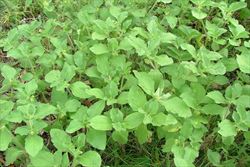
habit (Photo: Sheldon Navie)
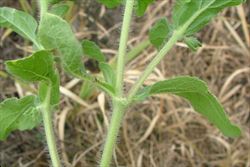
hairy branched stems and paired leaves (Photo: Sheldon Navie)

hairy leaves with slightly toothed margins (Photo: Sheldon Navie)

close-up of young flower-head and leaf undersides (Photo: Sheldon Navie)

older flower-head with fruit beginning to develop (Photo: Sheldon Navie)

immature fruit (Photo: Sheldon Navie)
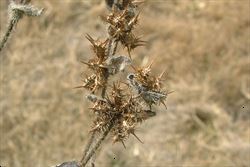
spiny mature fruit (Photo: Sheldon Navie)
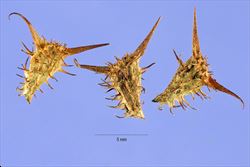
close-up of seeds (Photo: Steve Hurst at USDA PLANTS Database)

young plant (Photo: Sheldon Navie)

habit of old plants (Photo: Sheldon Navie)
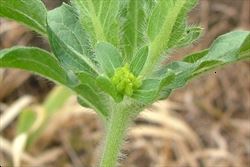
close-up of young flower-head showing its hairy floral bracts and flower buds (Photo: Sheldon Navie)
Scientific Name
Acanthospermum hispidum DC.
Family
Asteraceae (Queensland, New South Wales, the ACT, Victoria, Tasmania, Western Australia and the Northern Territory)
Compositae (South Australia)
Common Names
bristly star bur, bristly star-bur, bristly starbur, bristly starburr, goathead, goat's head, goat's-head, hispid starrburr, slingshot weed, star burr, starbur, starburr, Texas cockspur, upright star burr, upright starbur
Origin
This species is native to Central America (i.e. Costa Rica, El Salvador, Guatemala, Honduras and Nicaragua), parts of the Caribbean and tropical South America (i.e. French Guiana, Guyana, Surinam, Venezuela, Brazil, Bolivia, Colombia, Peru, Paraguay, Uruguay and northern Argentina).
Naturalised Distribution
Starburr (Acanthospermum hispidum) is widely naturalised throughout northern and eastern Australia. It is widespread in Queensland, in the northern parts of the Northern Territory, and in the Kimberley region in northern Western Australia. It has also been recorded in north-western and south-western Western Australia and is present in many parts of northern New South Wales (north from Kendall).
A small number of plants were also reported to be growing in the Maffra area of Gippsland in eastern Victoria in 2004. These plants were thought to have originated from a load of contaminated peanut straw imported from Queensland. Hence, this species is now regarded as being sparingly naturalised in Victoria.
Starburr (Acanthospermum hispidum) is also widely naturalised in other parts of the world including Africa, India, Sri Lanka, Thailand, Indonesia, Papua New Guinea, Hawaii and the southern parts of the USA.
Habitat
A weed of pastures, crops, disturbed sites, roadsides and waste areas in the warmer (i.e. tropical, sub-tropical and semi-arid) climatic regions of northern Australia. It is also often very common in alluvial soils along waterways and on floodplains in rangelands and natural areas in these regions. This species has also occasionally been found growing in warmer temperate regions in southern Australia.
Habit
An upright (i.e. erect), or occasionally low-growing (i.e. decumbent), short-lived (i.e. annual) herbaceous plant growing 15-100 cm tall, but usually less than 50 cm in height.
Distinguishing Features
- a stiffly hairy short-lived herbaceous plant usually growing less than 50 cm tall.
- its leaves are stalkless, covered in stiff hairs, and borne in pairs along the stems.
- its inconspicuous yellowish-green flowers are borne in the forks of the leaves near the top of the plant.
- its fruit develop into 5-10 spiny wedge-shaped 'seeds' which radiate outward and form a distinctive star-shaped 'burr'.
Seedling
The two seed-leaves (i.e. cotyledons) are light green or yellowish-green in colour and broadly oval (i.e. elliptic) in shape (about 10 mm long and 7 mm wide). They are hairless (i.e. glabrous), borne on short stalks (i.e. petioles) about 2 mm long, have entire or slightly wavy margins, and sometimes have a slight notch at the tip. The first true leaves are egg-shaped in outline (i.e. ovate) or somewhat triangular in shape with slightly toothed margins. They are also light green in colour, but are sparsely hairy (i.e. pubescent).
Stems and Leaves
The slender stems are generally round in cross-section and densely covered with stiff, sometimes sticky, hairs. They regularly divide in two (i.e. they are dichotomously branched) near the top of the plant. These stems are dull green when young but turn brown as the plant matures.
The leaves (2-12.5 cm long and 1-3 cm wide) are borne in pairs along the stems (i.e. oppositely arranged) and are either stalkless (i.e. sessile) or shortly-stalked (i.e. petiolate) with a winged base up to 10 mm long. They are egg-shaped in outline (i.e. ovate) or oval (i.e. elliptic) in shape with pointed tips (i.e. acute apices). These leaves can have entire, wavy, shallowly toothed (i.e. crenulate), or slightly lobed margins and both leaf surfaces (and their margins) are covered in stiff hairs.
Flowers and Fruit
The inconspicuous greenish-yellow coloured flower-heads (i.e. capitula) are borne singly on short stalks (i.e. peduncles) ranging from 1-15 mm long. These flower-heads (4-5 mm across) are found in the forks (i.e. axils) of the leaves, and sometimes also in the forks of the branches, near the top of the plant. They have an outer row of 4-6 shorter greenish bracts (3-5 mm long) and an inner row of 5-10 longer bracts that become spiny as the fruit develops. Each flower-head (i.e. capitulum) also has several (5-8) inconspicuous yellow 'petals' (i.e. ray florets), that are shorter than the bracts, and at its centre there are several (about 7) tiny yellow tubular flowers (i.e. disc florets) that are less than 2 mm long. Flowering occurs mostly during summer and autumn (i.e. from January to May).
The flower-heads quickly develop into five to ten spiny wedge-shaped 'seeds' (i.e. cuneate achenes) which radiate outward and form a yellowish-brown to dark brown star-shaped 'burr' (10-18 mm across). Each of these 'seeds' (i.e. achenes) is about 4-7 mm long when mature and covered in short hooked prickles, with two much larger spreading spines (3-4 mm long) at its tip.
Reproduction and Dispersal
This plant reproduces only by seed. Its 'burrs' are very commonly dispersed after becoming attached to animals, clothing and vehicles. They are also dispersed by water, particularly during floods, and as a contaminant of agricultural produce (e.g. in fodder and grain).
Environmental Impact
Though this species is largely seen as a pest of agicultural ecosystems (i.e. summer cropping systems and rangelands) in northern and eastern Australia, it is also regarded as an environmental weed in the northern parts of the country (i.e. in northern Queensland, the Northern Territory and northern Western Australia). In these areas it is known to invade native rangeland pastures and out-compete more desirable native species, particularly along waterways and on nearby floodplains. This not only has a negative impact on the productivity of these pastures but also effects their biodiversity. Starrburr (Acanthospermum hispidum ) has also invaded national parks and aboriginal lands, where it may cause even more significant environmental damage.
For example, starrburr (Acanthospermum hispidum) is seen as a threat to the Flora River Nature Park in the northern parts of the Northern Territory. It is one of several species of particular concern in this reserve, because it is common in surrounding areas and could easily invade the park through flood waters, feral animals, wandering stock, vehicles and visitor activities. Starrburr (Acanthospermum hispidum) is also ranked as a high priority weed in aboriginal lands of the Northern Land Council area, and listed as an environmental weed in the Townsville City Council region. It was also recently listed as a priority environmental weed in two of Australia's Natural Resource Management regions.
Other Impacts
As has been already mentioned, starrburr (Acanthospermum hispidum) is a weed of summer crops and pastures in northern and eastern Australia. It is considered to be a major crop weed in northern Queensland and the Northern Territory, and is commonly found in plantation crops, soybeans, sugar cane, peanuts and cotton. This species is also an alternative host for a number of insect pests and viral diseases that attack crops.
Starrburr (Acanthospermum hispidum) can significantly reduce the productivity of native pastures and is generally not grazed by livestock. It is also known to be toxic to goats. The spiny burrs are a troublesome contaminant of wool and are also known to cause minor injuries to livestock, people and native animals. They often also contaminate tropical pasture seed lots (e.g. cowpeas, siratro and stylos) and harvested fodder material such as hay.
Legislation
This species is declared under legislation in the following states and territories:
- Northern Territory: B - growth and spread of this species to be controlled (throughout all of the Territory), and C - not to be introduced into the Territory.
- Western Australia: Prohibited - on the prohibited species list and not permitted entry into the state.
Management
For information on the management of this species see the following resources:
- the Northern Territory Department of Natural Resources, Environment and The Arts Agnote on this species, which is available online at http://www.nt.gov.au/weeds.
Similar Species
Starburr (Acanthospermum hispidum) is usually easily distinguished by its burrs and is therefore rarely confused with other species. However, it is somewhat similar to the closely related Paraguay burr (Acanthospermum australe). These two species can be distinguished by the following differences:
- starburr (Acanthospermum hispidum) is a semi-upright to upright (i.e. decumbent to erect) plant growing up to 1 m tall. Its wedge-shaped 'seeds' (i.e. cuneate achenes) are covered with small hooked prickles, and also have two larger spines near their tips.
- Paraguay burr (Acanthospermum australe) is a creeping (i.e. prostrate) plant usually less than 10 cm tall. Its oval-shaped 'seeds' (i.e. ellipsoid achenes) are covered with small hooked spines, that are all about the same size.

